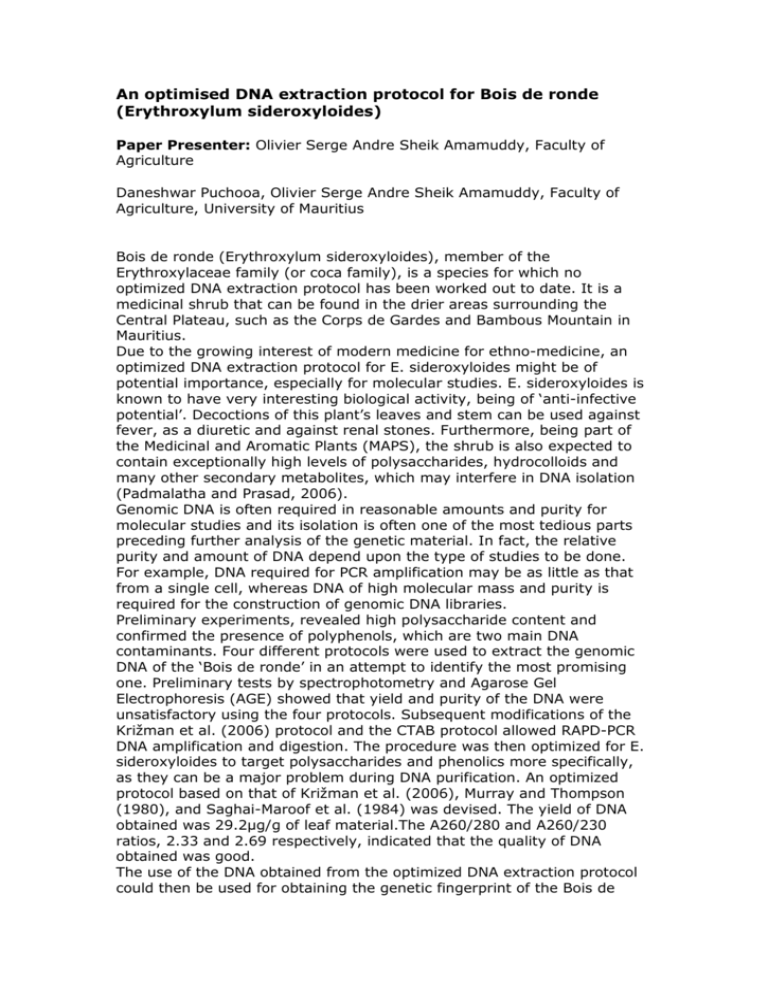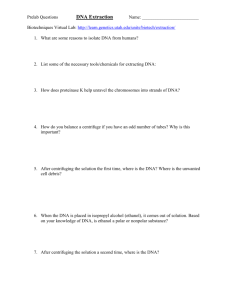An optimised DNA extraction protocol for Bois de ronde
advertisement

An optimised DNA extraction protocol for Bois de ronde (Erythroxylum sideroxyloides) Paper Presenter: Olivier Serge Andre Sheik Amamuddy, Faculty of Agriculture Daneshwar Puchooa, Olivier Serge Andre Sheik Amamuddy, Faculty of Agriculture, University of Mauritius Bois de ronde (Erythroxylum sideroxyloides), member of the Erythroxylaceae family (or coca family), is a species for which no optimized DNA extraction protocol has been worked out to date. It is a medicinal shrub that can be found in the drier areas surrounding the Central Plateau, such as the Corps de Gardes and Bambous Mountain in Mauritius. Due to the growing interest of modern medicine for ethno-medicine, an optimized DNA extraction protocol for E. sideroxyloides might be of potential importance, especially for molecular studies. E. sideroxyloides is known to have very interesting biological activity, being of ‘anti-infective potential’. Decoctions of this plant’s leaves and stem can be used against fever, as a diuretic and against renal stones. Furthermore, being part of the Medicinal and Aromatic Plants (MAPS), the shrub is also expected to contain exceptionally high levels of polysaccharides, hydrocolloids and many other secondary metabolites, which may interfere in DNA isolation (Padmalatha and Prasad, 2006). Genomic DNA is often required in reasonable amounts and purity for molecular studies and its isolation is often one of the most tedious parts preceding further analysis of the genetic material. In fact, the relative purity and amount of DNA depend upon the type of studies to be done. For example, DNA required for PCR amplification may be as little as that from a single cell, whereas DNA of high molecular mass and purity is required for the construction of genomic DNA libraries. Preliminary experiments, revealed high polysaccharide content and confirmed the presence of polyphenols, which are two main DNA contaminants. Four different protocols were used to extract the genomic DNA of the ‘Bois de ronde’ in an attempt to identify the most promising one. Preliminary tests by spectrophotometry and Agarose Gel Electrophoresis (AGE) showed that yield and purity of the DNA were unsatisfactory using the four protocols. Subsequent modifications of the Križman et al. (2006) protocol and the CTAB protocol allowed RAPD-PCR DNA amplification and digestion. The procedure was then optimized for E. sideroxyloides to target polysaccharides and phenolics more specifically, as they can be a major problem during DNA purification. An optimized protocol based on that of Križman et al. (2006), Murray and Thompson (1980), and Saghai-Maroof et al. (1984) was devised. The yield of DNA obtained was 29.2µg/g of leaf material.The A260/280 and A260/230 ratios, 2.33 and 2.69 respectively, indicated that the quality of DNA obtained was good. The use of the DNA obtained from the optimized DNA extraction protocol could then be used for obtaining the genetic fingerprint of the Bois de ronde species, adding up to the pool of information about potentially exploitable genetic resources found in Mauritius. The plant’s genetic fingerprint can then be used for identification purposes. This information will be very handy in the preservation of Intellectual Property and the endemic status of the species to both Mauritius and Réunion Island. It could also aid in bioprospection purposes and help prevent cases of biopiracy. Keywords: Genomic DNA extraction, Erythroxylum sideroxyloides, Bois de ronde, Erythroxylaceae, activated charcoal, medicinal.








